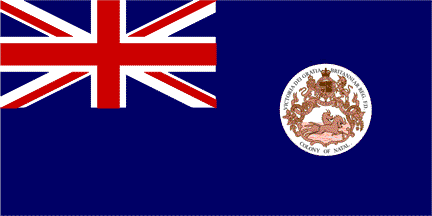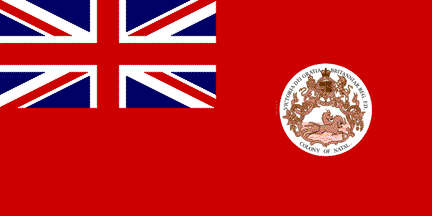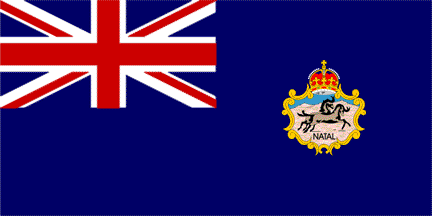 image by Martin Grieve, 09 Apr 2003
image by Martin Grieve, 09 Apr 2003 
Last modified: 2007-02-10 by bruce berry
Keywords: natal | gnus: 2 |
Links: FOTW homepage |
search |
disclaimer and copyright |
write us |
mirrors
 image by
Martin Grieve, 09 Apr 2003
image by
Martin Grieve, 09 Apr 2003
 image by Martin Grieve, 09 Apr 2003
image by Martin Grieve, 09 Apr 2003
Yes - SAVA published a Journal entitled "The Union Jack over Southern
and Central Africa, 1795 - 1994" [brl94] in 1994 which covers all these flags (and
those used in what is now Zimbabwe, Lesotho, Botswana, Malawi etc).
Natal - Red and Blue Ensigns with badge in fly (1870 - 1910)
Natal - simplified version of badge on blue ensign (1907 - 1910)
Bruce Berry, 7 Oct 1996
There is a problem concerning the Natal flags. My information does not
agree with two items in:
The Southern African Vexillological Association Journal (SAVA) SJ: 3/94, 'The
Union Jack Over Southern and Central Africa 1795 - 1994' by F.G.Brownell, [brl94]
and 'Sovereign Flags of Southern Africa' by A.P.Burgers [bur97].
1. Was the first badge used on the Red
Ensign?
Both books have illustrations of the ensign, but the text, page 25
in the Journal, reads, "A physical example of this Red Ensign is in the
Killie Campbell Museum in Durban." According to an illustration in
C. Pama's 'Lions and Virgins' [pam65] the flag in the museum has a variation of
the badge, in which the royal arms have no supporters and the wildebeest
are running in the opposite direction.
I am sure that there was no official Natal Red Ensign, but am quite
prepared to believe that there might have been unofficial ensigns that
used the official badge, if there is any evidence.
2. When did the second badge replace
the first badge?
The books have 1875, but I am certain that the correct date is 1905.
On page 26 of the SAVA Journal is written: "In line with the Colonial
Office dictum of 23 August 1875, the device on the fly of
the Natal Blue Ensign was simplified as illustrated below."
This does not agree with the reply to that letter. The original
badge was in colour and the simplification was to change it from multi-colour
to monochrome, not from one design to another.
"16 February 1876. Government House, Maritzburg, Natal to Colonial
Office.
My Lord,
I laid your Lordship's Circular Despatch of 23rd August last before
the Executive Council, and with reference to the second paragraph of the
despatch I have the honour to state that the drawing of the Device of the
Colony of Natal was considered sufficiently correct, but the multiple
colouring of it was not approved, and the Colonial Engineer was instructed
to prepare a Device which should be of plain uniform colour (maroon recommended)
on a white ground. This has been done, and I enclose a coloured drawing
in duplicate of the badge, which I only received a few days ago, and which
I trust may not arrive too late for the purpose for which it is intended.
I have the honour to be, My Lord, Your Lordship's most obedient
humble servant,
Henry Bulver, Lieutenant-Governor."
The colour drawing, which had no garland around the badge, was passed on to the Admiralty.
"12 April 1876. Colonial Office to Admiralty.
I am directed by the Earl of Carnarvon to transmit to you, to be laid
before the Lords Commissioners of the Admiralty, a copy of a dispatch from
the Lieutenant-Governor of Natal, enclosing a revised drawing of the Device
to be borne on the flag to be flown by the Governor of that colony.
2. If their Lordships approve of the proposed change of colour
for the badge, I am to request to be furnished with six copies of the drawing
as it will appear in the Admiralty Flag book, for transmission to the colony
and for the record in this Department."
[National Archives (PRO) CO 323/326]
Approval of the revised badge was recorded In the Record Book [CO 325/54] The monochrome Natal badge appeared in the 1881 HM Stationery Office publication 'Arms and Badges of the Several Colonies of Great Britain.'
The second badge is in the Colonial Office Record
Book [CO 325/54] with a note; "1904. Admiralty presume direct on Blue Ensign,
but on a white disc in the Union Flag".
It was inserted into 1889 Admiralty Flag Book by amendment dated 31
May 1905.
David Prothero, 20 Apr 2003
The flag as depicted in 'Lions and Virgins' has the Wildebeests running toward heraldic Dexter i.e the other way from the ones in the first badge and in the Journal. Page 55 of 'Lions and Virgins' states: On the devise which came into being in 1870 the wildebeests are running from left to right, *except* on a flag in possession of the Killie Campbell library of Durban (also illustrated in R. Gerard: 'Flags over South Africa' p.38 [ger52]). This is a *Red Ensign* with the Natal emblem on the fly. This emblem shows the usual picture of the two wildebeest, but this time running from right to left and topped by a different version of Queen Victoria's arms, namely the Royal shield only, surrounded by the legend of the Order of the Garter and topped with a Royal crown but without the supporting lion and unicorn. It is obvious that this inset must have been taken from the colonial seal, there is no other possibility, but no other example of it has come to light.
In other words, this is (was), as I read it, the one sample known of
a Natal Red Ensign. Therefore the Red Ensign on p. 25 of the SAVA Journal
and the first badge, which is based on the depiction
in the Journal has the badge that is based on the Blue Ensign. I am sure
that there was no official Natal Red Ensign, but am quite prepared to believe
that there might have been unofficial ensigns that used the official badge,
if there is any evidence. Red Ensigns may have been very scarce at the
time, but in the mid 1990's they were in plentiful supply at all the Durban
tourist shops. I can't remember which version was being sold though, but
I think it was the version from the Journal as its manufacturer was a member
of SAVA (The Miss Killie Campbell's Red Ensign: see below).
André van de Loo, 20 Apr 2003
Some notes on the Natal Red
Ensign:
My business partner local artist
Ted Brandon and I, were responsible for researching and reviving the Natal Red Ensign in the mid-1980s. Natal had always
had a strong British connection and was considered a renegade Province
by the rest of the country at that time. Ted designed the famous bumper
sticker which had the fly half of the Union Jack on the right and the 1875 Captain
Hine version of the Natal Arms on the left. The Sticker was red with the
legend "Natal - the last outpost."
The design was derived from the Natal Red Ensign which from our research, seems
to have been in use fairly extensively. The evidence is as follows.
1. The Killie Campbell Red Ensign whilst itself obviously being a home
made job, is indicative of its existence elsewhere.
2. The Natal Technical College in Pietermaritzburg had a Natal Red
Ensign which was flown each year on graduation day and possibly on other special
occasions. This was properly manufactured
and proportioned and had the Captain Hine Coat of Arms but with a much simplified
colour scheme i.e. black on khaki. The Principal of the College claimed that
the flag was an original relic from pre-Union days. Two other examples existed-one
was displayed in the entrance hall of the old Natal Assembly Building and
one was displayed in the Durban History Museum. The latter was a reproduction
produced by another Durban Manufacturer. It is possible that the Tech example
was also a reproduction, but even if it was, it again begs the question -
reproduced
from what example?
3.The Harbour master or Port Captain flew a Natal ensign pre-Union, which
considering its Maritime/Civilian locality, was almost certainly a Red Ensign.
4.Several monochrome photos exist of the ensign pre-Union. One particular
photograph taken on the Durban beachfront circa 1905 shows a display of
two governors flags and two Ensigns. Whilst obviously one can not be certain
whether the Ensigns are red or blue ,they appear lighter than the Union Jack blue
in the rest of the flag and on a balance of probabilities, are thus likely to
be Red Ensigns.
When one considers that there are no relic Natal Blue Ensigns (apart
from, as far as I am aware, the Royal Natal Yacht Club Ensign) all the evidence points to a
Natal Red Ensign ' a la Canada'. Also Captain Hines Wildebeest were in retreat.
This
was corrected by the York Heralds in 1904/5. The modern Natal Arms had them
in full charge towards the enemy!
Geoff Caruth, 15 May 2003
![[Old Natal colony seal]](../images/z/za)nt70.gif) image
by Martin Grieve, 08 Apr 2003
image
by Martin Grieve, 08 Apr 2003
The legislative Council of the Colony of Natal adopted in August 1870 a Red
and Blue Ensign bearing the Colonial Seal on a white roundel as a charge on the
fly. The Seal was of a standard type in use in British Colonies since 1839, and
may be described as follows:
'Within a Chippendale-type frame, on a plain, two Wildebeest (gnus) in full
course at random (to sinister) with the words COLONY OF NATAL beneath the frame.
The frame itself is ensigned with the Royal Arms, and around the circumference
appears the legend VICTORIA DEI GRATIA BRITANNIA REG. F.D.'
This complicated design of the Seal did not lend itself to successful
application to flags. To make the legends readable from both sides,
manufacturers were obliged to sew two devices back to back and subsequently a a simplified
version of the badge was used as the device on
the fly of the Blue Ensign (see below). This was adopted by a dictum of the Colonial Office dated
23 August 1975. This device actually predates the granting of arms to the Colony
by Royal Warrant on 16 May 1907. The latter device may be described as follows:
'Within a gold Chippendale-type frame, in front of mountains and on a plain
two Wildebeest contourne' in full course, side by side, proper, therebeneath the
name NATAL in black letters, the frame ensigned of a Royal Crown, also proper'.
Jarig Bakker, 24 Jul 1999
![[Old Natal colony flag]](../images/z/za-ntgv1.gif) image
by Martin Grieve, 08 Apr 2003
image
by Martin Grieve, 08 Apr 2003
Note there is a black circle around the badge in the
centre on this occasion. Otherwise the Governor of Natal's flag followed the usual
pattern used in the British Colonies, and placed the badge within laurel Garland
on the Union Flag.
Martin Grieve, 17 Apr 2003
There is a Flag of the Governor of Natal (colonial flag) at eBay. For image click
here.
Union flag with complex Victorian badge: 'Within a Chippendale-type
frame, on a plain, two Wildebeest (gnus) in full course at random with
the words COLONY OF NATAL beneath the frame. The frame itself is ensigned
with the Royal Arms, and around the circumference appears the legend VICTORIA
DEI GRATIA BRITANNIA REG. F.D.' Flag measures approx. 6' x 3' (1.8 m x
0.9m). This replica was made ca. 1995.
Bill Garrison, 18 Jun 2002
![[Miss Killie Campbell's Red Ensign]](../images/z/za_natkc.jpg) scan by David Prothero, 21 Apr 2003
scan by David Prothero, 21 Apr 2003
I remember seeing many stickers on the back windows of cars in 1990.
These stickers were split vertically showing the Union Flag on the left,
and the badge of the Colony of Natal to the right on a *red* field with
the words "The last outpost". I stand to be corrected here, but I seem to
remember that the badge used was the second badge as described below . This of course is most
certainly not official, and could have been the result of "Artistic license" .
Natal is often referred to (light-heartedly), here in South Africa,
as "The last outpost of the British Empire" and the police force
in Durban are *officially" called "The Durban Metropolitan Police"
as opposed to the "South African Police"
Martin Grieve, 21 Apr 2003
A distinctive version of the Blue Ensign was authorised for the Colony of Natal
(shown above) and bore on a white roundel in the fly a representation of the Natal Colonial
Seal which was approved by the Legislative Council as a flag device in August
1870, namely:
Within a Chippendale-type frame, on a plain, two Wildebeest in full course at
random (to sinister) with the words COLONY OF NATAL beneath the frame. The frame
itself is ensigned with the Royal Arms, and around the circumference
appears the legend VICTORIA DEI GRATIA BRITANNIA REG. F.D.'
The complicated nature of this design of the Seal did not lend itself to successful
application to flags. To make the legends readable from both sides,
manufacturers were obliged to sew two devices back to back. In line with
the Colonial Office dictum of 23 August 1875 the device on the fly of the Natal
Blue Ensign was simplified. This device may be described as follows:
'Within a gold Chippendale-type frame, in front of mountains and on a plain
two Wildebeest contourne' in full course, side by side, proper, therebeneath the
name NATAL in black letters, the frame ensigned of a Royal Crown, also proper'.
This simplified device thus predates the grant of Arms to Natal on 16 May
1907.
nt05.gif) image by Martin Grieve, 08 Apr 2003
image by Martin Grieve, 08 Apr 2003
A "simplified" version of the Natal Blue Ensign thus replaced the earlier
version containing the full Colonial Seal in the fly. According to
Brownell in "The Union Jack over Southern and Central Africa, 1975-1994"
[brl94]
there does not appear to have been a Red Ensign version of this flag.
Bruce Berry, 08 Apr 2003
 image by Martin Grieve, 08 Apr 2003
image by Martin Grieve, 08 Apr 2003